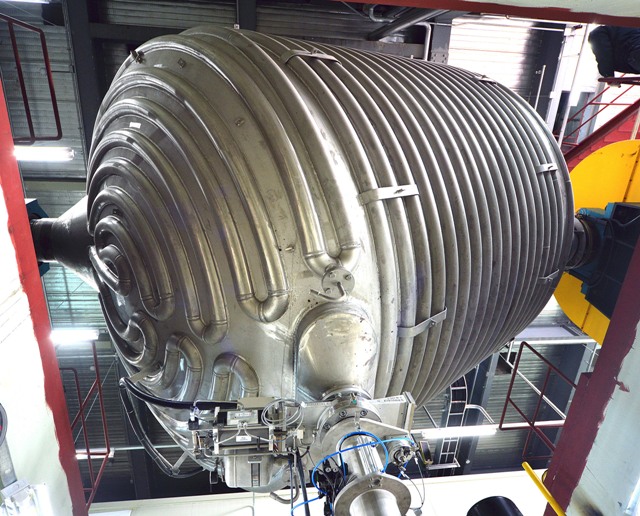At this year's Chinaplas from May 20 to 23 in Guangzhou/China, ProTec Polymer Processing will present efficient and economical plant engineering solutions for material treatment of plastics. The highlights of the presentation are the completely revised new generation of the ProTec tumble reactor for selectively improving the properties of free-flowing plastics and the pultrusion technology used to manufacture long-fiber reinforced thermoplastics (LFT).
 The new-generation ProTec tumble reactor (shown here, the installation of a reactor with a volume of 36 m³ at the production location): The heat transfer oil now passes through half-pipe coils welded to the reactor vessel, thus significantly improving process stability and energy efficiency. Pictures: ProTec Polymer Processing
The new-generation ProTec tumble reactor (shown here, the installation of a reactor with a volume of 36 m³ at the production location): The heat transfer oil now passes through half-pipe coils welded to the reactor vessel, thus significantly improving process stability and energy efficiency. Pictures: ProTec Polymer Processing
The ProTec tumble reactor is particularly suitable for post-condensation of pellets of polyester (PET, PBT, PEN, etc.) and of polyamides such as PA 6, PA 6.6, etc. These “refined” materials are used to manufacture a range of products such as bottles as well as fibers or technical yarns that are required for optical fibers, tire cords as well as airbags, fiber composite materials, filter fabrics, fleece fabrics, and even fishing nets. Long-fiber reinforced thermoplastics with fibers of pellet length are processed using the injection-molding technique – ideal for LFT with a 12 mm fiber length – and produce high-strength components that also offer excellent surface quality. The ProTec system technology is suitable for the production of a broad range of materials with different types of fiber reinforcement and very diverse compounded polymer matrices, also directly during LFT production. Even the technically challenging combination of carbon fibers with PP can be reliably produced.
SSP Reactor with New, Improved Standard
The tumble reactor from ProTec, available in sizes from 16 m³ to 44 m³, is an SSP (solid-state post-condensation) reactor that operates discontinuously. Thanks to batch-based operation and the ability to regulate the reaction conditions – temperature, vacuum, and reactor residence time – the achievable characteristics of the material can be selectively controlled. The reactor is set at an inclined position to the horizontal rotational axis. The resulting tumbling rotation ensures permanent, gentle mixing and, consequently, very homogeneous product characteristics inside the reactor.
As an evolution of the tried and tested OHL tumble reactor, the new generation of the ProTec tumble reactor offers further improved process stability along with greater flexibility and energy efficiency. In addition, the reactor no longer features a double jacket but is designed as a single-shell unit. A multi-duct system of half-pipe coils for transporting the heat transfer oil is welded to the outside of the vessel. This enabled the amount of oil required to temper the contents of the reactor to be reduced by roughly one third. The optimized weight of the reactor vessel combined with a gear wheel direct drive system enabled energy consumption to be reduced by around 25 % compared to the predecessor. Batch times required for material treatment have also been cut. In addition to post-condensation and decontamination of polyamides and polyesters, the ProTec tumble reactor is also used in the chemical and pharmaceutical industry for systematically and gently improving the properties of free-flowing solids.
High-Quality LFT Materials – Now Also with In-Line Compounded Matrix Material
With LFT pultrusion technology, ProTec Polymer Processing has developed a production system that is precisely geared towards the economical production of high-quality thermoplastics with fibers of pellet length. LFT materials with fiber lengths (pellet lengths) of 7 mm to 25 mm are the industry norm. The fiber strands – made of either glass or carbon fibers – are isolated to create the filaments before being uniformly coated (impregnated) with the polymer melt in the impregnation die. The fiber-polymer strands are then pelletized once they have cooled. Fiber content of up to 60 percent by weight and plant sizes with throughputs of up to 1,200 kg/h are possible.
ProTec has now developed the technology to the stage where it can even reliably produce LFT from carbon-fiber-reinforced PP – a material combination that was previously extremely difficult or impossible to be realized. Instead of using a single-screw extruder as standard for material processing, the pultrusion line can also be equipped with a twin-screw extruder. This "in-line compounding" makes the process more flexible and allows the fiber-matrix compound to be optimally and individually adapted to the respective application. At the same time, profitability, energy efficiency, and the environmental footprint are improved because the polymer matrix is processed in the melt stage immediately after the compounding process.
In addition to being extremely strong, stable, and resistant to impact, lightweight components manufactured using LFT exhibit excellent heat resistance. Since LFT can be processed using injection-molding techniques, components can be manufactured cost-effectively. Automotive engineering in particular is currently a field of application for LFT. However, the advantages of this group of materials will not only have a lasting effect on the evolution of parts and components for the automotive industry in the future. Even bioplastics can be "upgraded" in this way. In the form of LFT, they achieve the characteristics of engineering plastics.
ProTec Polymer Processing GmbH based in Bensheim, Germany, has been a recognized partner to plastics processing and manufacturing companies for many years. The service portfolio includes systems for efficient handling of plastic materials, turn-key systems for solid-state-post-condensation of plastics, recycling plants as well as complete systems for producing long-fiber reinforced thermoplastics (LFT pultrusion lines). As a member of the Schoeller Group, ProTec Polymer Processing has access to a global sales and service network and offers an optimum infrastructure for comprehensive on-site customer support.